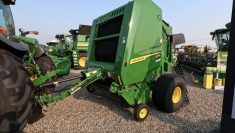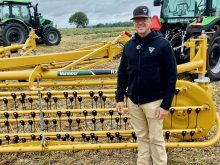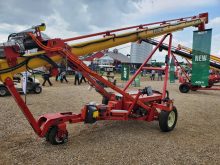Computers are standard tools on farms today.
Wireless networks known as WiFi have greatly expanded farmers’ ability to use computers, smartphones and other electronics to connect wirelessly to larger networks, including the internet.
Yet limitations on their use continue, mostly due to technological limits and the costs involved.
Bill Moffitt is hoping to change that.
His system enables computers to connect from 40 times further away, while also providing more power.
Moffitt started Ayerstone Productivity because he saw a need for larger networks in rural areas.
Read Also

China’s grain imports have slumped big-time
China purchased just over 20 million tonnes of wheat, corn, barley and sorghum last year, that is well below the 60 million tonnes purchased in 2021-22.
“Our equipment will reach out in open areas about a half mile. That means that farmers can use a large variety of tools in ways and in places they haven’t before,” he said.
“And, if they want, they can surf the internet on the deck or in the barn or shop,” said the president of the St. Paul, Minnesota, company.
With an aspect of the technology, called meshing, more than one of his $250 hubs can be installed around the farm, creating a radio repeater system that increases the coverage. It can extend over large areas, potentially covering bigger blocks of land for up to three kilometres.
“In the city, you likely wouldn’t want to potentially share your computer network with everybody in the neighbourhood. In the countryside that isn’t as much of an issue,” he said.
The system uses standard password protection for security, but the system is too powerful for practical urban use.
Industry Canada regulates how many watts of effective isotropic radiation power, or EIRP, can be used to broadcast and receive a signal for WiFi. In Canada and the United States, it is four.
“We designed a system with a high quality antenna that uses all four. It’s weatherproof and mounts outside, to boost its effectiveness,” Moffitt said.
“It will reach long distances with very high (data transfer rates), even with little netbook computers like mine, that have very weak little radio (transceivers).”
Moffitt’s hubs can also connect any computer or digital piece of equipment that can normally be attached to a wired, ethernet network.
That includes the latest in WiFi compatible cellphones and other internet devices.
“Lots of farms have replaced walkie-talkies with cellular phones. But the connections can be iffy in some places and their data use can be slow. Many newer phones are WiFi compatible,” he said.
Those phones and internet devices can default to WiFi networks in place of cellular links when the faster and free WiFi connections are available.
This improves connections, allows faster internet and e-mail access and eliminates the cellular data and talk time costs.
Using a second hub, a network compatible data reader, non-wireless computer or other peripheral device such as a printer or camera can be attached to the farm’s local area network.
Each of the hubs has an ethernet, Institute of Electrical and Electronics Engineers 802.3 standard RJ45 connection, allowing cabling into the system.
“In Idaho we have cattle producers that have put readers on gate openings to feed and water points in pastures. The (radio frequency identification) ear tags (on the cattle) are read when the animals pass through those gates. If an animal doesn’t come in for a day, you know you have to get the horse or quad and go looking to check out its health and situation,” Moffitt said.
“There are plenty of monitoring applications. Cameras in barns and corrals, or in grain operations, where there are risks of injury, cameras can be attached and then monitored in the house or office on a local area network or via the internet anywhere you want to be.
“The network systems that have been in place in agriculture and for rural industry have been very expensive. They generally involved hiring someone to provide hardware and then there were the challenges of getting it set up and running. We don’t have those (information technology) issues,” said Moffitt.
“Typically the cost of this technology would have been $3,000 and up. We come in at $250, with expansion costs of $250 per hub.”
The Ayerstone Ayermesh units are self configuring. The user plugs them into the computer’s existing area network, radio, satellite, digital subscriber line (DSL) cable modem or ethernet connection and the hub takes care of the rest of the setup.
The modem is known as a piece of customer premises equipment, or CPE, and is generally the contact point for the system.
The system is also compatible with slower cellular based data modems.
The units are about the size of a portable radio and rely on 110 volt power.
“Our networks aren’t for a larger business where they would need an IT department or network controls like throttling (of data) and that sort of thing. They are for farms. They support a lot of devices and users, but not for larger businesses that would need (what are commonly called) an enterprise solution,” said Moffitt.
The Ayermesh talks to the network and the internet via the usual dynamic host configuration protocol, DHCP, and generally does so through a point to point protocol over ethernet, PPPOE, or via an internet protocol, IP, address. This is important to know when questions come up whether it is compatible with a current system.
“The answer is generally, always, ‘yes’, ” said Moffitt.
If the current modem or CPE has a wireless feature, it is turned off once the Ayerstone unit is installed.
Moffitt said the software that he provides with his hubs controls the network and creates a web portal. Network security is provided through a data encryption system.
“It is state of the art. No unwanted users will be getting in,” he said.
Ayerstone is developing remote hub power systems that will use wind, solar and batteries to provide hubs that can stand alone in field or pasture situations.
For more information contact: 888-837-0637 or www.ayerstone.com. The company sells its products online at http://ayrstone-productivity.amazonwebstore.com/.














